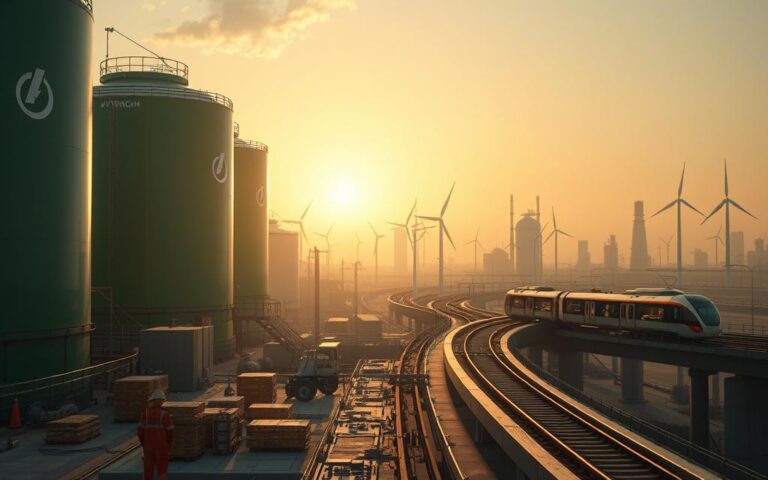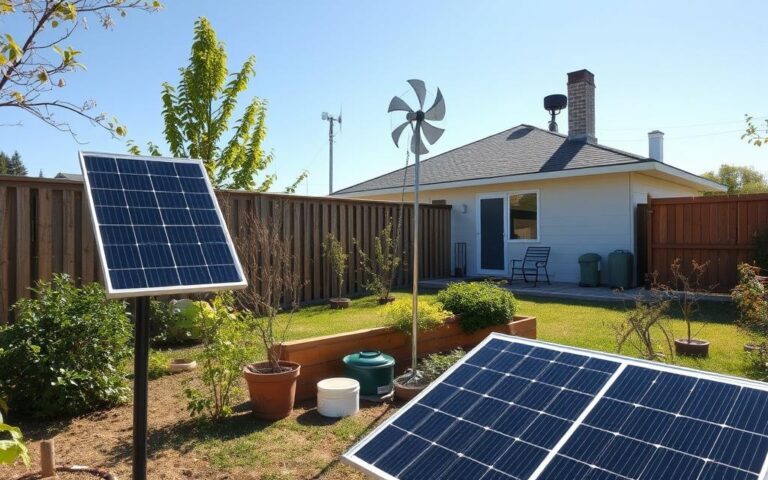
Nearly 19 million Americans in rural areas lack reliable electricity. This creates a need for innovative off-grid renewable energy solutions. The sustainable power landscape is changing, offering new chances for energy independence.
Off-grid renewable energy is a game-changer for isolated regions. These systems provide sustainable power alternatives, reducing reliance on traditional infrastructure. Rural communities can now generate their own electricity using cutting-edge technologies.
Off-grid energy solutions offer more than just power generation. They unlock economic opportunities and improve life quality in remote areas. Solar, wind, and micro-hydro systems are becoming more accessible.
Investments in off-grid renewable energy help communities overcome infrastructure limits. These solutions provide electricity and drive economic growth. They also promote environmental sustainability and technological innovation in rural America.
Understanding Off-Grid Renewable Energy Systems
Off-grid power generation offers sustainable solutions for remote communities and eco-conscious individuals. These systems provide electricity without traditional power grids. They use renewable energy components to create self-sufficient power networks.

Renewable energy tech has transformed power generation. It enables communities to achieve grid independence. This approach generates electricity from constantly replenished natural resources.
Types of Off-Grid Power Generation
- Solar Photovoltaic Systems: Converts sunlight directly into electrical energy
- Wind Turbine Generators: Harness wind power for electricity production
- Micro-Hydro Power: Generates electricity from flowing water sources
- Biomass Energy Systems: Converts organic materials into usable power
Basic Components of Off-Grid Systems
| Component | Function | Typical Lifespan |
|---|---|---|
| Solar Panels | Energy Generation | 25-30 years |
| Battery Bank | Energy Storage | 5-15 years |
| Inverter | Converts DC to AC Power | 10-15 years |
| Charge Controller | Regulates Battery Charging | 10-20 years |
Grid Independence vs. Traditional Power Supply
Grid independence offers many benefits over traditional power supply. It reduces electricity costs and increases energy reliability. Users can generate their own power, free from centralized electrical grids.
This approach also minimizes environmental impact. Renewable energy components make it possible to create sustainable power systems.
The future of energy lies in decentralized, sustainable power generation systems that empower communities and protect our planet.
Solar Power: The Foundation of Off-Grid Living
Solar panels have changed off-grid energy for remote U.S. communities. They provide reliable power, transforming how people get electricity in isolated areas. This tech lets people make clean energy from sunlight.
Off-grid solar energy offers many benefits. These include low upkeep, scalable power, and lower setup costs. It’s also good for the environment.
- Minimal maintenance requirements
- Scalable power generation
- Decreasing installation costs
- Environmental sustainability
Modern solar panels work well in different climates. Technological advancements have made them more efficient. This makes them great for remote places.
Places like Alaska and Arizona now use these renewable energy solutions. They work well even in tough conditions.
“Solar technology empowers communities by providing independent, clean energy access,” says renewable energy expert Dr. Sarah Rodriguez.
Off-grid solar energy isn’t just for homes. Small businesses, farms, and schools in remote areas use it too. It gives them reliable power.
As solar tech improves and gets cheaper, it opens up more chances for growth. This helps remote areas develop in a sustainable way.
Wind Energy Solutions for Remote Areas
Wind energy offers a powerful off-grid power option for remote U.S. locations. Small-scale wind turbines are crucial for communities seeking sustainable, independent energy solutions.
Off-grid wind power brings unique benefits to areas with limited electricity access. These systems turn wind into reliable energy, supporting far-flung communities.
Small-Scale Wind Turbines: Powering Remote Communities
Off-grid wind turbines come in various sizes and designs. They have key features that make them ideal for remote use.
- Compact design suitable for individual households
- Low maintenance requirements
- Adaptability to diverse geographical conditions
- Capacity to generate 1-10 kilowatts of electricity
Wind Energy Assessment Strategies
Successful wind energy projects need thorough wind resource assessment. Experts look at key factors to see if a project can work.
| Assessment Factor | Evaluation Criteria |
|---|---|
| Wind Speed | Average annual wind velocity |
| Terrain Characteristics | Landscape topography and wind patterns |
| Turbine Placement | Optimal location for maximum energy capture |
Maintenance Considerations
Good upkeep ensures wind turbines last long and work well. Regular checks and care help avoid problems in remote energy systems.
- Annual comprehensive system check
- Lubrication of moving components
- Structural integrity assessment
- Electrical system verification
Wind energy keeps improving, offering new ways to generate power in tough U.S. regions. It’s a promising option for sustainable, local energy production.
Energy Storage Technologies and Battery Systems
Energy storage is vital for off-grid power systems. It ensures reliable electricity generation and distribution. Battery systems are key to efficient off-grid power storage.
These systems have changed how remote communities use renewable energy. They offer new ways to access and manage power.
Different battery technologies suit various off-grid needs:
- Lead-acid batteries: Cost-effective and reliable for basic energy storage needs
- Lithium-ion batteries: High energy density and longer lifecycle
- Flow batteries: Scalable and ideal for large-scale energy storage
Choosing the right energy storage solution requires careful thought. Consider these key factors:
- Capacity requirements
- Climate conditions
- Budget constraints
- Expected system lifespan
Advanced battery management systems boost performance and lifespan. Smart monitoring technologies track battery health in real-time. This ensures top efficiency and prevents unexpected power cuts.
| Battery Type | Energy Density | Lifecycle | Cost Efficiency |
|---|---|---|---|
| Lead-Acid | Low | 300-500 cycles | Economical |
| Lithium-Ion | High | 1000-2000 cycles | Moderate |
| Flow Batteries | Medium | 4000-5000 cycles | Higher initial investment |
New technologies are expanding off-grid energy storage options. Hydrogen fuel cells and advanced pumped hydro storage show promise. These innovations could bring more sustainable power to remote areas.
Micro-Hydro Power: Harnessing Natural Water Sources
Micro-hydro power offers a renewable energy solution for off-grid communities near flowing water. It turns water’s movement into electricity. This sustainable option works well for remote locations with access to water sources.
Off-grid hydroelectric systems benefit communities near streams, rivers, and small water channels. When done right, this technology generates steady electricity. It also causes minimal harm to the environment.
Site Selection Criteria
Successful micro-hydro power installations need careful site evaluation. Important factors include water flow rate and available water head (vertical drop).
Other key elements are a consistent water source and minimal seasonal changes. The system’s proximity to community infrastructure also matters.
- Water flow rate
- Available water head (vertical drop)
- Consistent water source
- Minimal seasonal variations
- Proximity to community infrastructure
Environmental Impact Considerations
Responsible micro-hydro power requires thorough environmental assessment. Developers must evaluate potential impacts on local ecosystems and wildlife.
They should also consider effects on water quality and downstream usage. These factors help ensure the project’s sustainability.
- Local aquatic ecosystems
- Wildlife migration patterns
- Water quality
- Downstream water usage
Installation and Operation
Micro-hydro power systems use special equipment to convert water flow into electricity. Proper design and maintenance are crucial for long-term performance and reliability.
Modern off-grid hydroelectric systems can generate 10-100 kilowatts of power. This output can support small communities or remote facilities. Micro-hydro power’s scalability makes it suitable for various geographical settings.
Economic Benefits and Cost Analysis
Off-grid energy costs reveal a transformative approach to renewable energy economics. Remote communities are finding major financial advantages in independent energy systems. The initial investment may seem high, but long-term savings are impressive.
The financial perks of energy independence go beyond utility savings. Communities with off-grid solutions enjoy reduced energy expenses and local job creation. They also gain economic resilience and less reliance on external power infrastructure.
“Energy independence is not just an environmental choice, but a smart economic strategy for sustainable development.” – Clean Energy Research Institute
A thorough cost analysis shows renewable energy systems offer substantial economic benefits. Small rural communities in Montana and Wyoming have seen remarkable financial changes with off-grid technologies.
The economics of off-grid energy systems involve several key financial factors. These include initial capital investment, operational maintenance costs, energy production efficiency, and long-term savings potential.
- Reduced long-term energy expenses
- Local job creation in renewable energy sectors
- Enhanced economic resilience
- Decreased dependence on external power infrastructure
- Initial capital investment
- Operational maintenance costs
- Energy production efficiency
- Long-term savings potential
Renewable energy economics are rapidly evolving, making off-grid solutions increasingly attractive for communities seeking financial and energy independence.
Government Incentives and Support Programs
Renewable energy incentives can help lower costs for off-grid energy projects. The U.S. government offers various programs to support sustainable energy in remote areas. These initiatives make eco-friendly tech more affordable for communities seeking energy independence.
Federal incentives provide crucial financial backing for off-grid energy grants. The Investment Tax Credit (ITC) and Residential Renewable Energy Tax Credit are key programs. Rural Energy for America Program (REAP) grants also offer support.
- Investment Tax Credit (ITC) for renewable energy systems
- Residential Renewable Energy Tax Credit
- Rural Energy for America Program (REAP) grants
- State-specific renewable energy incentive programs
Government programs focus on different parts of off-grid energy growth. The Department of Energy teams up with state agencies. Together, they create funding chances for sustainable energy projects.
| Program Type | Financial Benefit | Eligibility |
|---|---|---|
| Federal Tax Credits | 26% of system costs | Residential and commercial installations |
| USDA Rural Energy Grants | Up to $20,000 | Rural community projects |
| State Renewable Incentives | Varies by state | Local renewable energy initiatives |
Researchers and community leaders can leverage these government support programs to make off-grid energy solutions more economically viable and environmentally sustainable.
Conclusion
Renewable energy is changing how remote communities get power. Off-grid solutions offer a path to sustainable development. These technologies provide clean, reliable electricity without relying on centralized grids.
Remote communities are using renewable energy for economic and environmental gains. Solar, wind, and micro-hydro systems are solving energy challenges. These solutions create growth opportunities and reduce carbon emissions.
Tech advances make off-grid options more accessible and efficient. Better battery storage and sophisticated systems promise energy independence. U.S. regions can use these innovations for resilient, self-sufficient power.
Supporting off-grid energy is key to a sustainable future. We must work together to adopt these transformative technologies. This collaboration will ensure a cleaner, more empowered future for everyone.
FAQ
What are off-grid energy solutions?
Off-grid energy solutions are independent power systems. They generate and store electricity without using the traditional grid. These systems often use renewable sources like solar, wind, or micro-hydro power.
They provide energy independence for remote areas. Communities without reliable electrical infrastructure benefit from these solutions.
How much does an off-grid energy system cost?
Off-grid energy system costs vary widely. Factors include size, technology, and community needs. Residential systems can cost between $10,000 and $50,000.
Larger community installations may exceed $100,000. Long-term savings and government incentives can offset these upfront costs.
Which renewable energy source is best for off-grid applications?
The best renewable energy source depends on local conditions. Solar power is versatile and works well in many environments. Wind energy excels in open areas with steady winds.
Micro-hydro systems are ideal for locations with reliable water sources. Each option has its strengths based on geographic factors.
What government incentives are available for off-grid energy projects?
The U.S. offers several incentives for off-grid energy projects. These include federal tax credits of up to 30% for renewable installations. State-level grants and local programs also support sustainable energy development.
The Investment Tax Credit (ITC) benefits off-grid projects. The USDA Rural Energy for America Program (REAP) is another helpful resource.
How long do off-grid battery systems last?
Modern lithium-ion batteries typically last 10-15 years with proper care. Lead-acid batteries have a shorter lifespan of 5-7 years. Factors like discharge depth and temperature affect battery longevity.
Regular maintenance is key to maximizing battery performance and lifespan.
Can off-grid systems work in extreme climates?
Yes, advanced off-grid systems can function in diverse environments. They work from Alaska’s cold regions to Arizona’s deserts. Proper system design is crucial for reliable performance.
Appropriate equipment selection and protection ensure success in challenging conditions.
What maintenance do off-grid energy systems require?
Off-grid systems need regular upkeep. This includes annual solar panel cleaning and battery checks. Inverter and charge controller inspections are also important.
Monitoring system efficiency and replacing components when needed is crucial. Professional yearly maintenance ensures optimal system performance and longevity.
How do off-grid systems handle energy storage?
Energy storage is vital for off-grid systems. They typically use battery banks to store excess energy. Modern systems often prefer lithium-ion batteries for their efficiency.
These batteries offer longer lifespans and faster charging than lead-acid alternatives. Proper storage ensures consistent power supply during low production periods.



